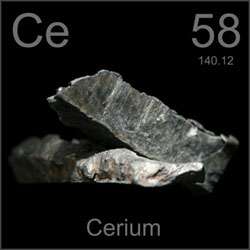Cerium's unusual behaviour

(PhysOrg.com) -- Livermore researchers have found that a crystal of cerium -- the chemical element that can be used for catalysts and fuel additives -- behaves in very unique ways when subjected to high pressures.
When a solid is pressurized, the internal energy at some point produces a change in the atomic arrangement, called a phase transformation. Typically when this happens, the atomic arrangement changes from one geometry to another. However, that doesn't happen in cerium.
When cerium metal is exposed to 75,000 atmospheres of pressure, the atomic arrangement of the crystal simply shrinks, is transformed into two crystals. Dan Farber, Kevin Moore, and Chantel Aracne-Ruddle showed that the two crystals are the same structure (one a large cube and the other a small cube) and have the same spatial orientation (the large and small cubes face in the same direction). This means that the two phases have the same crystal structure, but different volumes. This is entirely unique in phase transformations of solid materials.
A phase transformation with two crystals of the same structure, but different volumes is something akin to laying bricks that are the same shape, but where some of the bricks are large while some are small. Making a coherent wall with the two is difficult.
The team (which also included researchers from Université Pierre et Marie Curie, Place Jussieu and CEA, DAM, DIF, all in France) used a diamond anvil cell to create the intense pressures on the cerium crystal. They also applied the X-ray diffraction method to determine the high pressure variation of the cerium structure and volume.
"Our data clearly show that the transformation mechanism can be described on the basis of crystallographic and thermodynamic arguments, showing a fair agreement with an isomorphic scenario and the existence of a critical point," Moore said. "The equation of state of cerium near the critical temperature is determined experimentally and for the first time is shown to be well understood in the framework of the scaling theory of the liquid-gas transition of classical systems. This conclusion represents an important step forward in achieving a reliable and unambiguous picture on the mechanism of phase transformation in cerium, an element archetypical of the localization-delocalization phenomenon encountered in f-electron systems, such as plutonium."
The research is scheduled to appear in a future edition of Physical Review Letters.
Provided by Lawrence Livermore National Laboratory


















